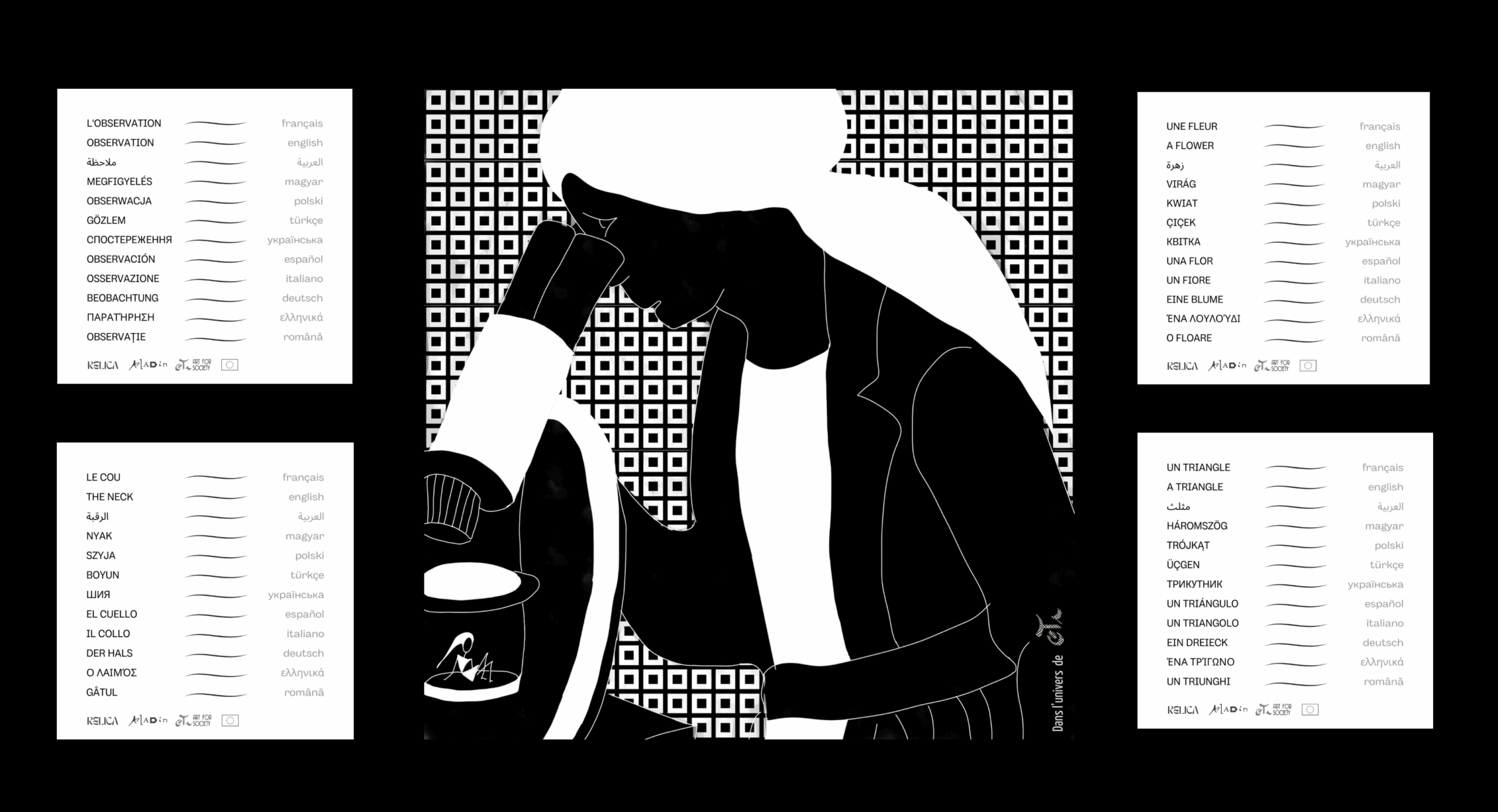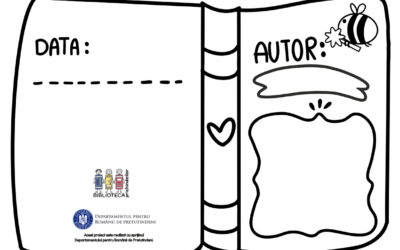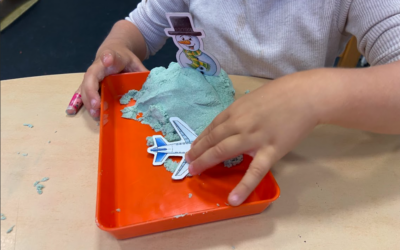The Intruder – Card Game
The Intruder – Card Game
A Fun and Engaging Multilingual Card Game
L’Intrus is a versatile and interactive card game designed to enhance language learning across multiple levels (A1-C2) while fostering creativity, imagination, and cultural awareness. Perfect for classrooms or family gatherings, this game offers both online and printed versions, allowing players to explore language in a fun, dynamic way.
Time
20 minutes to 1 hour
Adults and children aged 6 and up
4 to 20 players
Language skills
Vocabulary building, Reading comprehension, Word recognition, Sentence formation, Syntax
Other skills
Creativity, Imagination development, Associative thinking
Levels
From A1 to B2
None, optionally drawing paper, pens and pencils

Languages Available
Step-by-step Guide
Online or in-person using a screen or projector
Online or in-person using a screen or projector
1. Start with the first slide, which displays the 8 dialogue cards. Ensure that all expressions are understood by the learners. Have them read each one aloud and copy them into their notebooks. To explain the meaning, ask learners to imagine situations in which they might use these expressions, or people to whom they might say them.
2. Move to the next slide and ask the first player to choose an expression that could serve as a title for one of the 8 displayed images. Instead of using the word “title”, you can also ask: “What do you think the person (or people) in this image is saying or thinking?” If the task seems too difficult, model the activity yourself by showing how it works.
3. The next player then tries to guess which image the first player had in mind. To identify the card, players can use the names shown on the back of the cards—these appear when you hover the cursor over the image in the online version. This allows learners to practice the question: “Is it the…?” or “Is it the one with…?
4. Scoring: If the guess is correct, the player earns 1 point. If not, to maintain motivation and self-confidence, give them a second chance: The first player can give a clue—such as describing something in the image other than the main element. Continue around the group so each player gets a turn.
5. In the online version (or on screen), expression cards are grouped in sets of 8, and each slide is followed by 5 slides containing drawing cards. You can decide when to move to the next slide to offer more choices to your learners.
6. Optional rules: For added challenge, introduce rules such as: Players cannot choose an image that has already been selected by someone else.
Complementary Exercises – Discovering Artistic Heritage: All the cards feature the phrase “In the universe of…”, referencing various artists from around the world.
-
- Levels A1–A2: Read the names of the artists aloud. Conduct simple online research to learn more about them. If you have access to books or albums by the referenced artists, bring them to class. Ask learners to find and read the titles of artworks they like.
- Levels B1–B2 Complete the tasks above. In addition, ask learners to express their opinions and preferences about the artworks they discover.
- Levels C1–C2: Go further by identifying recurring cultural symbols or themes in the artworks. Lead a discussion on the meaning, origin, and significance of these elements.
Step-by-step Guide
Version with Printed Cards
Version with Printed Cards
1. Prepare two decks: One deck with vocabulary image cards and one deck with dialogue expression card
2. Place 8 vocabulary cards face up on the table, either randomly or pre-selected around a specific theme you want to focus on.
3. Each participant draws 1 to 4 dialogue cards, depending on how much time is available.
4. Ask them to read the expressions aloud and explain what they mean.
5. Everyone should write the sentences down in their notebooks
6. Using the dialogue cards in their hand, players choose titles for the images on the table.
7. Interactive element: When a player correctly guesses the image chosen by the previous player, they keep the corresponding card—adding a playful, competitive aspect to the game.
8. After a card is taken, replace it with a new one from the vocabulary deck.

For Educators, Teachers and Parents
In the following section you’ll find additional information to help you adapt this activity for different audiences, language abilities and group sizes. This information should help educators and teachers to adapt the activity to meet the specific needs of different learners and to ensure accessibility, engagement and effectiveness in different learning environments. Optionally, we also give advices to parents how to condct the activity at home.
Challanges
General Guidelines:
- Identify learners’ language level (A1 to C2) and adapt the game rules accordingly, based on the PDF version.
- Prepare your materials:Use the online version for group work on a screen. Use the printed version for more tactile, interactive work.
- Plan an introduction to the vocabulary or expressions featured on the cards to support comprehension.
Pedagogical Tips:
- Start as a group: Explore the expressions or vocabulary together and ensure everyone understands them.
- Encourage speaking: Each player should explain their choices, ask questions, and describe images. This helps develop oral fluency and active language use.
- Emphasize reformulation and detailed description (especially from level B1 onward) to strengthen expressive skills.
- Use the game variations to diversify learning:
- Storytelling with cards
- Memory games or syntax-based activities
- Image-to-sound or image-to-situation associations
Tip: Link to Visual Art
Take advantage of the artistic references on the cards (“In the universe of…”) to introduce a cultural dimension. You can:
- Assign mini-research projects on the artists
- Show the original artworks in class
- Discuss their style, origin, or message
Recommendations for teachers
- Choose Age-Appropriate Texts
Select engaging and level-appropriate stories that match students’ reading abilities.
Use familiar topics to boost interest and comprehension.
- Adapt to Different Skill Levels
- For beginners: Use shorter passages with simple words and encourage oral sentence formation.
- For advanced learners: Choose longer passages with more complex vocabulary and ask them to write sentences.
- For beginners: Use shorter passages with simple words and encourage oral sentence formation.
- Make It Interactive
- Encourage students to read the passage aloud before starting the activity.
- Let them work in pairs or small groups to find words together.
- Incorporate a Discussion Phase
- After underlining words, ask students to explain their meaning or use them in a new context.
- Encourage questions to ensure comprehension.
- Use a Variety of Texts
- Rotate between fiction, non-fiction, poetry, and informational texts. This helps students develop different reading skills and expand their vocabulary
- Adapt to Language Proficiency Levels
- For beginners, allow students to use visual aids or provide a word bank of possible items.
- For more advanced learners, challenge them to add descriptive details about their items (e.g., “I will take a warm, cozy sleeping bag.”).
- Encourage Active Participation
- Use gestures, facial expressions, or real-life objects to engage younger students.
- Allow students to act out or mime their items to make the game more interactive.
- Use Thematic Variations
-
-
- Change the setting of the trip (e.g., a trip to space, a jungle adventure, a visit to a castle).
- Require students to only choose items that start with a specific letter or belong to a certain category (e.g., food, tools, clothing).
- Provide Scaffolding for Struggling Learners
- Write down the list on the board as students add items to help them follow along.
- Repeat the list together as a class before each new turn to reinforce memory.
-
Recommendations parents
-
Recommendations for Parents
Playing at Home:
- Choose the printed version for a quiet, more focused moment, or the online version for a livelier, group activity.
- Feel free to adapt the rules for a shorter or simplified game depending on your child’s age and attention span.
- Encourage your children to tell a story using the cards, even if it’s a creative, imaginative tale. The key is to feel comfortable expressing themselves.
Multilingualism:
- If your family is bilingual, play in two languages.
- For example, associate a card with a word or expression in the original language, then reformulate it in French.
- This is also a great game to share cultural or linguistic memories—such as family anecdotes, expressions, or traditions.
What to Keep in Mind:
- Don’t overwhelm players: Start with 4 to 6 cards maximum for a manageable experience.
- Avoid putting pressure on finding the “right answer”: Emphasize imagination, idea association, and the effort to formulate thoughts.
- In group settings, make sure that everyone has a clear visual access to the cards, especially with printed versions.
Adaptation/Application of the method
Variants
Adjustments and Additions for Levels B1–B2
- Encourage players to create their own titles for the image cards.
- The next player must describe the image in more detail before identifying it. Example: Instead of saying “Is it the carpet?”, say “Is it the character sitting on a flying carpet?”
Adjustments and Additions for Levels C1–C2
- Encourage players to choose enigmatic or ambiguous titles that could apply to several cards.
- The player who guesses the card must describe in detail what they see in the image.
Alternative Game Modes
For Young Children
- Find the intruder (the odd one out) among a set of cards.
- List visible objects in the image.
- Associate a sound with the image and imitate it.
For Older Children and Adults
- Group cards into sets of 4 with something in common.
- Storytelling: Create a story using 3 to 5 cards.
- Syntax game: Build a sentence using multiple cards.
- Memory game: Match cards based on criteria set by the players.
Visual Creation Exercise – Make Your Own Cards
-
Step-by-Step Instructions:
- Prepare blank cards by printing and cutting them. On the back, write short phrases such as: I + verb + object/place/time complement (e.g., “I eat an apple,” “I run in the park,” “I sleep late.”)
- Practice drawing simple characters using triangles.
- Show learners how to do this step-by-step.
- Distribute the cards (or let learners choose one).
- Each learner draws the scene that matches the sentence on their card.
- Collect the drawings and display them to the group.
- Explain that every sentence starts with “I”, followed by a verb and a complement.
- The group tries to guess the original sentence for each drawing.
- You decide whether they say it aloud or write it down.
Variant – For a More Challenging Game:
- Distribute completely blank cards (both sides).
- Each learner writes a sentence in the form “I + verb + complement”.
- They then pass the card to the next person, who draws the scene on a new blank card.
- That drawing is passed to another person, who writes a new sentence describing what they see.
- The pattern continues: one person draws, the next writes, and so on.
- At the end of the round, compare the original sentence to the final one—
- The difference is often funny and thought-provoking!
References and Resources
Online Resources for Variants and Alternative Games
- Online version: https://view.genially.com/67b8352ac922e4934a56bc18
- Printable cards: https://cotaassociation.wixsite.com/learing/intrus-jeu-mulilingue
- Find the Intruder: https://view.genially.com/67de64e7e2a42f8fc0ee6e31
- Match Images with Words and Find the Intruder: https://view.genially.com/6814568ea2cf09fb8b681cf6
- Complete the Sentences: https://view.genially.com/6814572d0a1e490c1e9a7986
- Strange Images – Develop Creative Skills through Absurdity: https://view.genially.com/681457b52dd0ce87628e3ab6
- What Do You Do When You Feel Sad or Disappointed: https://view.genially.com/681486f9ac06a7893f814fcf
- The Intruder and the Four Seasons (Full Module): https://view.genially.com/680f0fb141cab240301ccadc
- Stories Written by Water: https://view.genially.com/680c7c0d41cab240307715cf
Similar Activities
Storytelling
Short description of the method
Training Post
Let children be creative with kinetic sand as they explore textures, create shapes and bring their own imaginative stories to life with sand and cardboard characters in this interactive storytelling activity


